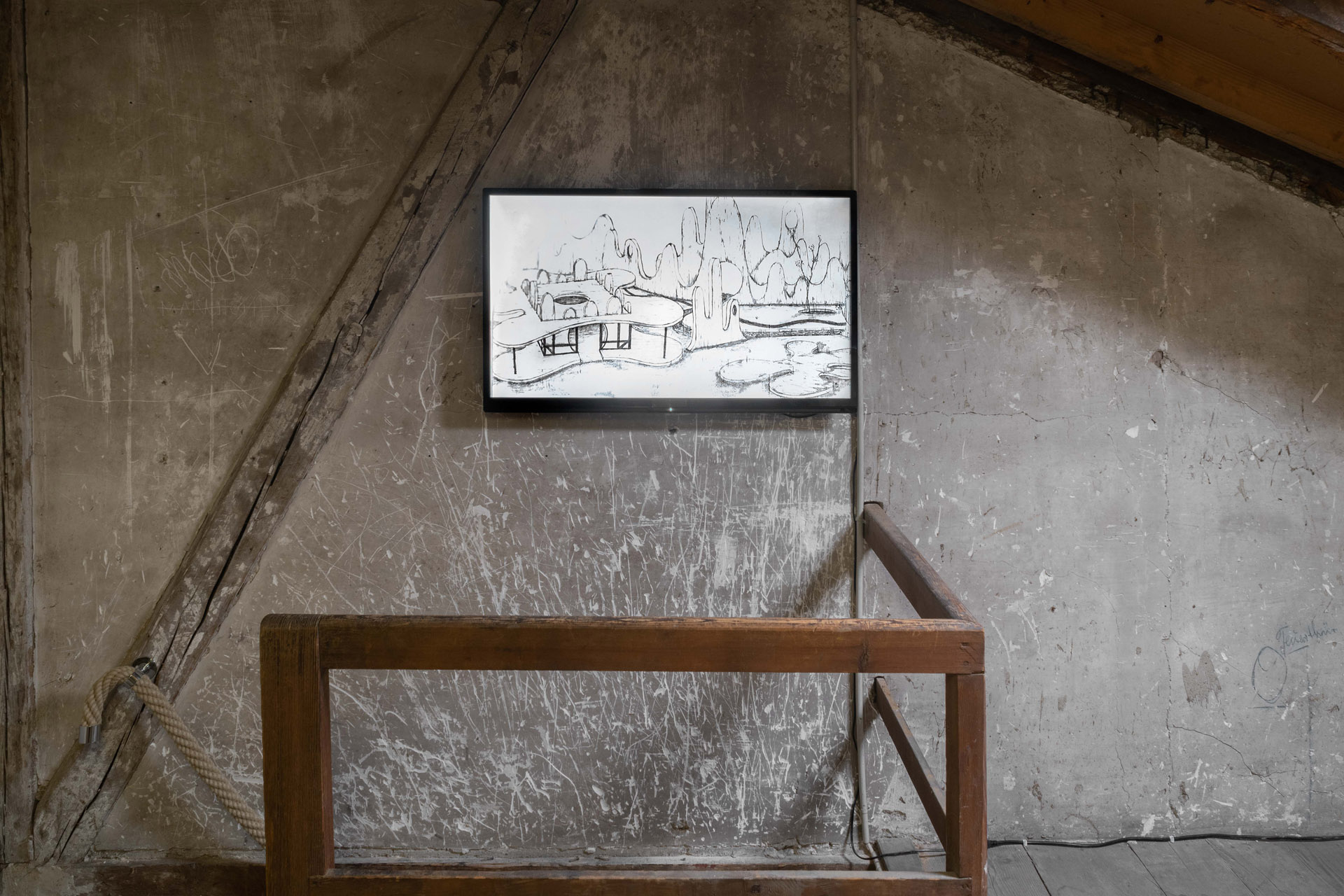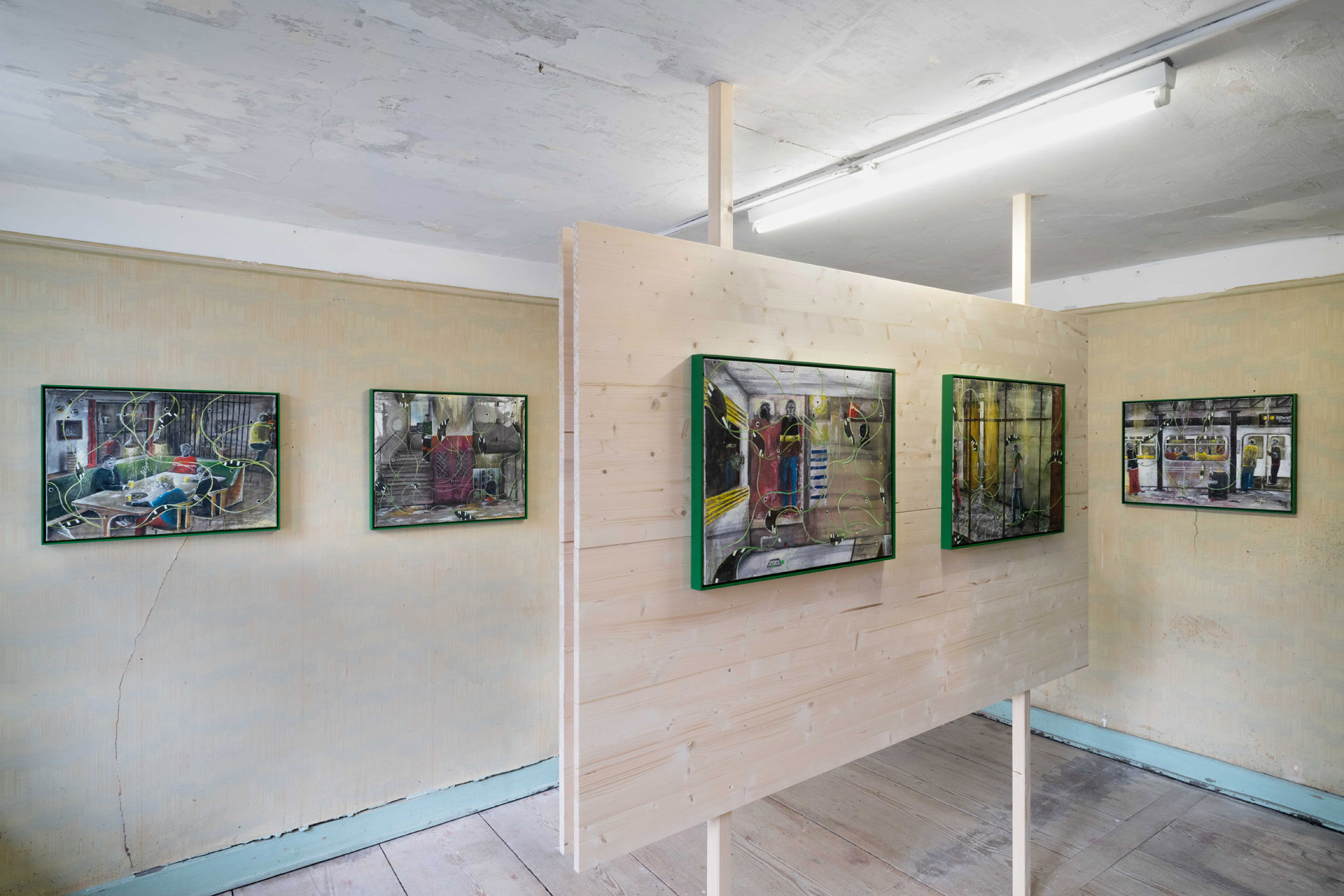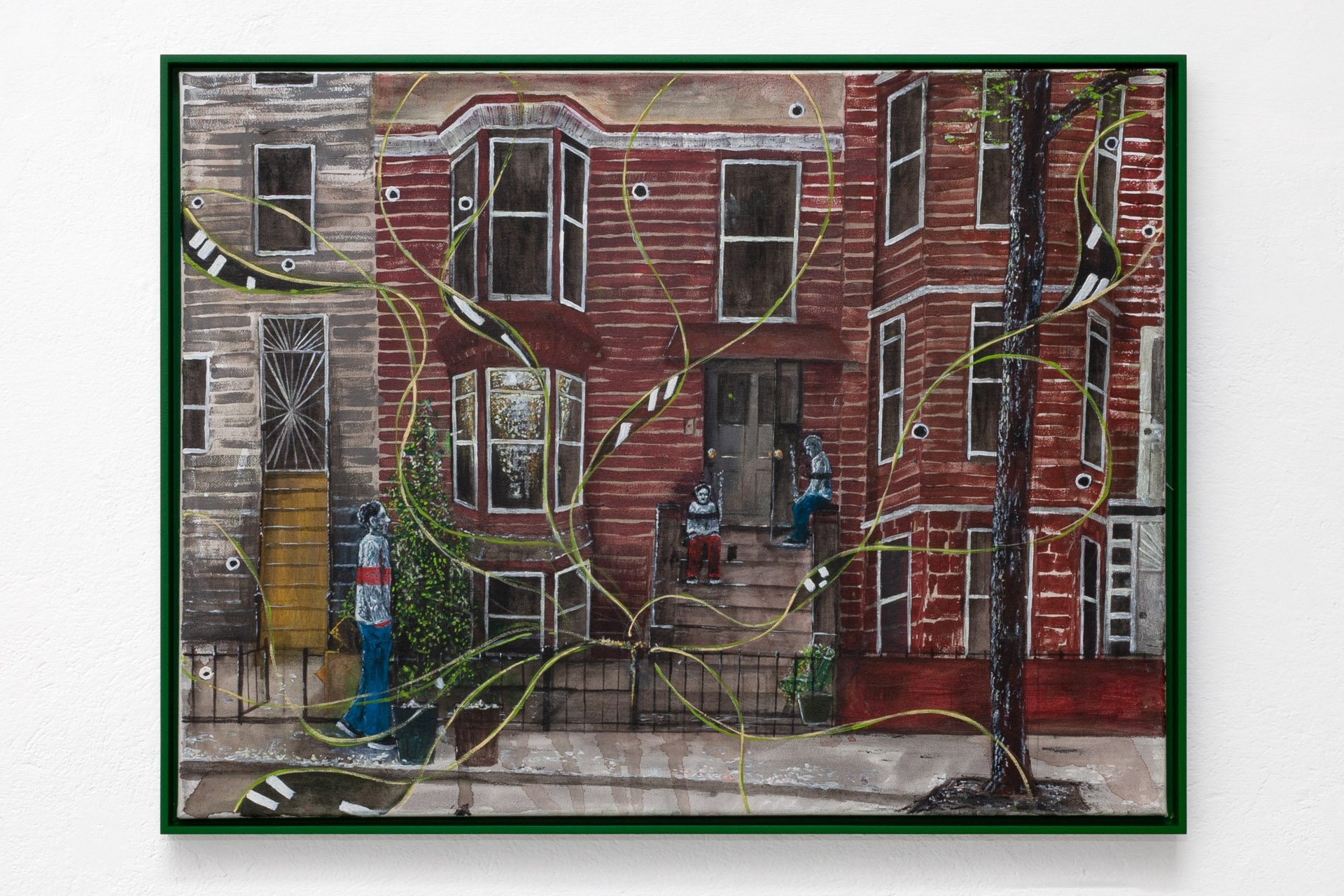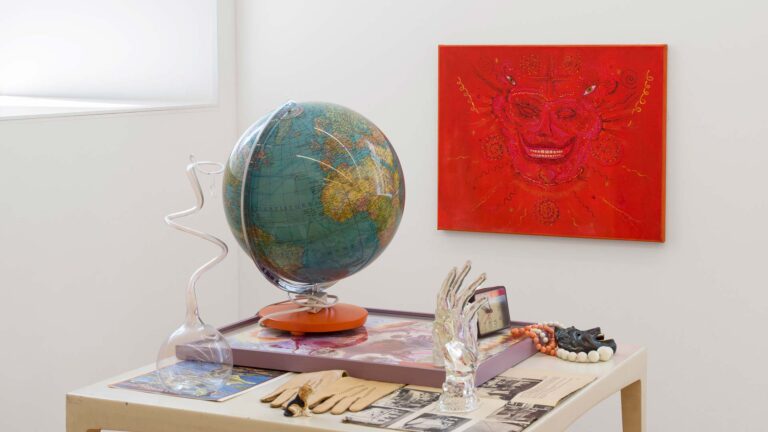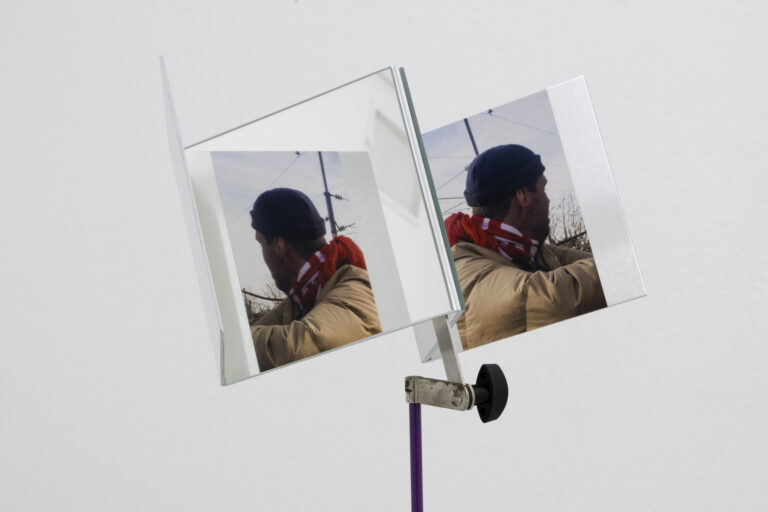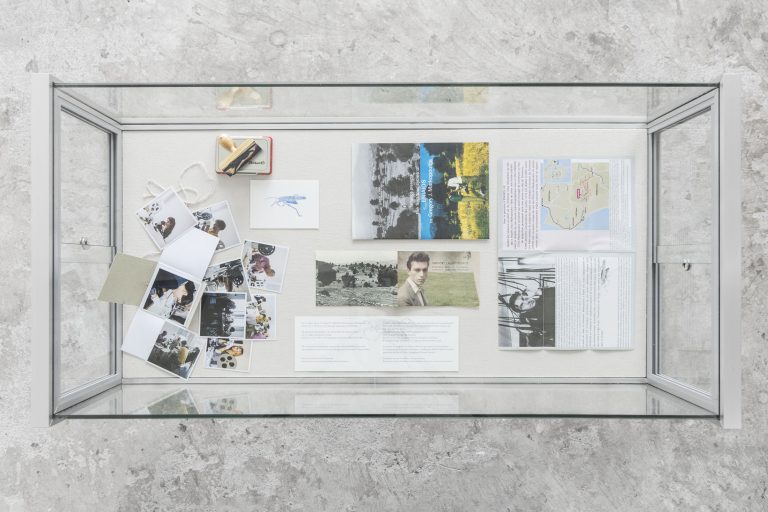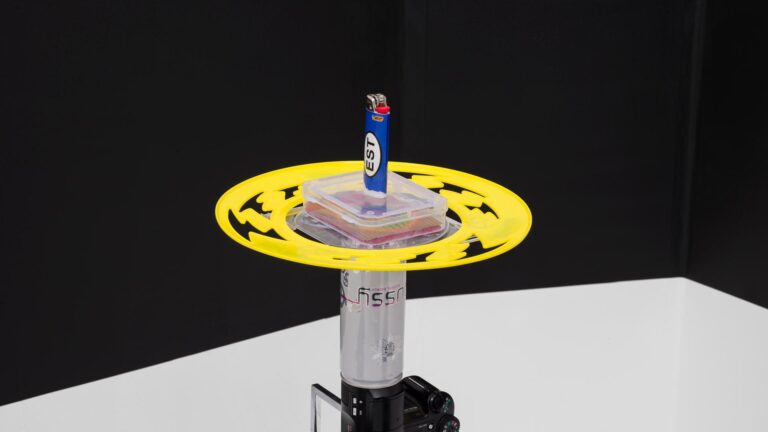Artist: Veit Laurent Kurz
Exhibition title: Thyroxin
Venue: Weiss Falk, Basel, Switzerland
Date: April 8 – May 8, 2020
Photography: images copyright and courtesy of the artists and Weiss Falk, Basel
Oskar Weiss and Oliver Falk are pleased to present Thyroxin, Veit Laurent Kurz’s second solo show at the gallery.
Le fantôme, c’est moi.
Deadly Dust is a painting we can find twice in Veit Laurent Kurz’s exhibition at Weiss Falk in Basel: as one of his series Ghost Paintings and in the film Domestic Monologue. It shows a sort of doppelganger scene featuring two mirror-image figures in a stairwell in the same posture, with the same gait and the same physique, each looking down at the steps, one walking up and the other down the stairs. They’re about to cross paths at the viewer’s eye level.
What’s going to happen? Nothing? Abysmal Hoffmannesque horror?
The dark, mottled backdrop creates a mood also found in the artist’s earlier works, forming an ambient noise for the overlying depiction of everyday domestic and urban scenes. And yet another dimension superimposes itself upon this eerie scene: a network of curved lines, between which cartoonish wide-open mouths and eyes appear – an effect that reminds one of Picabia’s “Transparencies”, and is similarly projected into the space in the shape of suspended sculptures.
The scenes seem to evoke personal experience and experiencing and a world teeming with anxieties, neuroses and phobias.
This private sphere is also present in the paintings’ titles, in the artist’s voiceovers, and in such recurring narratives and themes as the Chernobyl nuclear disaster, the traditional half-timbered houses of southern Germany and North American cityscapes and landscapes anywhere from New York City to Vancouver, all of which could serve to retrace the path of Kurz’s biography.
But something else also happens.
Considering the artist’s role in his own script, we could let Jacques Derrida speak: in Ken McMullen’s film Ghost Dance, to Pascale Ogier´s „Do you believe in ghosts?“, he answers:
Est-ce qu’on demande au fantôme s’il croit aux fantômes? Ici, le fantôme, c’est moi.(…) Au lieu de jouer mon propre rôle, je laisse un fantôme (…) parler à ma place. (Do you ask a ghost whether it believes in ghosts? Here, the ghost is me.(…) Instead of playing myself (…), I let a ghost (…) speak for me.)
It is in this sense that Kurz effectively employs the techniques of superimposition, overlapping and interleaving to depict the continual comings and goings of the ghosts that make our own experiences communicable (or bearable) in the first place. In his abundantly detailed environments, in which every liquor bottle gets a lovingly designed label and every figure its own genealogy, the ghosts can audition, read their parts, and be endured. And leave traces.
They appear vividly before us, not as pale functional references, but in the atmospheric lighting and description provided by the next, previous or concurrent one that speaks.
In this way, the contaminated cloud from the nuclear reactor that keeps on spewing eternally in this universe, for instance, condenses into a composite:
A tale passed down from one generation to another.
A privately mythologized world history.
A Freudian primal scene, after which the traumatizing reminiscences, the mysterious “fueros”, have finally found their ultimate translation as a little unpleasant, but at least measurable, nuclear rain.
The irradiated revenant of the spectre that was once haunting Europe.
It means tirelessly emptying out, clearing out and rearranging things to keep the banquet of transmission alive, although the alternating visitations never run smoothly anyway.
We seem to be glued to them, and it’s probably in moments of detachment that terror and fears are released. Kurz’s interest in the traumatic and repulsive, the poisoning and radiation, the abject one could say, is not an oath of allegiance to the authentic. It reflects the rage of the evicted residents and their thirst for revenge, and is grounded in separation as an inevitable consequence of the cascade of ghosts.
According to Julia Kristeva, this is the very process in which the outlines of the subject appear. In her “essay on abjection” entitled Pouvoirs de l’horreur (Powers of Horror), she writes:
A la lisière de l’inexistence et de l’hallucination, d’une réalité qui, si je la reconnais, m’annihile. L’abject et l’abjection sont là mes garde-fous. Amorces de ma culture. (On the edge of nonexistence and hallucination, of a reality that, if I acknowledge it, annihilates me. There, abject and abjection are my safeguards. The primers of my culture.)
Sebastian Wiegand
Berlin, April 2021




